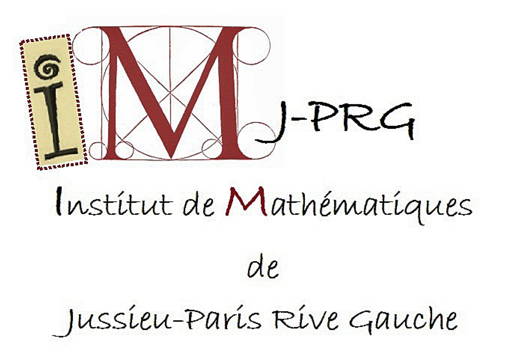
DESCRIPTIVE SET THEORY IN PARIS

 |
DESCRIPTIVE SET THEORY IN PARIS |
 |
| Joan BAGARIA | Principles of Structural Reflection and the Hierarchy of Large Cardinals |
| Riccardo CAMERLO | Invariantly universal analytic quasi-orders |
| Clinton CONLEY | Measurable chromatic numbers |
| Mirna DZAMONJA | A classification of measures |
| Marton ELEKES | Reflection of nonmeagerness in Cantor sets |
| Valentin FERENCZI | The isometry group of hereditarily indecomposable Banach spaces |
| Julien MELLERAY | The small density property for Polish topometric groups. |
| Benjamin MILLER | Komjáth-Laczkovich style dichotomies |
| Lionel NGUYEN VAN THE | Universal flows for closed subgroups of the permutation group of the integers |
| Vladimir PESTOV | Even larger groups: a glimpse over the horizon of Polishness |
| Slawomir SOLECKI | Generic measure preserving transformations and unitary representations of L0 |
| Todor TSANKOV | Unitary representations of oligomorphic groups |
| Jan VAN MILL | On countable dense and strong n-homogeneity |
↑top
↑top
↑top
↑top
This is joint work with Itaï Ben Yaacov. ↑top
↑top
↑top
↑top
↑top
↑top
Consistently there exists a Cantor set C such that every nonmeager set
is relatively nonmeager in a translate of C. This theorem, which
generalises results of Bartoszynski and Burke-Miller, was motivated by.
We describe the isometry group of hereditarily indecomposable spaces. As a consequence we solve a conjecture of Wood by giving an example of a space which does not admit an equivalent maximal norm, and answer a question of Finet and Godefroy by giving an example of a superreflexive space which does not admit an equivalent quasi-transitive norm.
This work is in collaboration with C. Rosendal.
I will discuss an approach to some problems related to automatic continuity in Polish groups, which is based on extending some classical results about subsets of Polish groups (most notably, Pettis' Lemma) to functions.
I will then explain how this point of view may be used to prove that some Polish topometric groups (which I will also define and discuss) satisfy a variant of the small index property. As an example, let us state this result in the particular case of the unitary group of an infinite-dimensional, separable Hilbert space:
Let G denote the unitary group, and let d be a seminorm on G which is lower semi-continuous with respect to the operator norm. Then d must be continuous with respect to the usual Polish topology of G.
We will discuss Komjáth-Laczkovich style generalizations of various descriptive set-theoretic dichotomy theorems..
In their 2005 paper, Kechris, Pestov and Todorcevic showed that in order to compute the universal minimal flow of some closed subgroups of the permutation group of the integers, two combinatorial properties are relevant. Those are respectively called "Ramsey property" and "ordering property". They proved that the ordering property is equivalent to minimality of a certain flow, while the conjunction of the Ramsey and the ordering property is equivalent to minimality and universality of this same flow. A natural question is therefore: Is Ramsey property alone equivalent to universality? The purpose of this talk is to give an answer to this question.
ANon-locally compact groups of automorphisms of various structures are often referred to as "large groups", and their theory is already quite mature. At the same time, some of its most interesting results have so far only been obtained in the Polish case.
Is the assumtion of Polishness essential or just a tribute to tradition? In this talk, we will examine what form some of the results and constructions assume in a non-separable case. One test case will be the Urysohn metric space and its group of isometries, where we point out links with some difficult open problems and discover a new phenomenon impossible to predict just by looking at the Polish case.
Consider the Polish group of all measure preserving transformations of Lebesgue measure with the canonical weak topology.
Using descriptive set theory, I will show that for a generic transformation
T in this group, the closed group generated by T is isomorphic to a subgroup of L0(measure, S1) that is the image of a closed linear subspace of L0(measure, R) via
e exponential map. This sharpens and generalizes older results of de la Rue, Sam Lazaro, Ageev, and others, which I will also survey. Expanding on the above theme, I will present a classification of unitary representations of L0(measure, S1).
The proof of this classification uses Kwapien's theorem on the structure of linear operators from L0(measure, R) to
L0(measure, R) as a main tool. .
I will discuss a new classification result for the unitary representations of oligomorphic permutation groups (or equivalently, automorphism groups of omega-categorical structures). It turns out that every such group has only countably many irreducible representations and it is possible to describe them quite explicitly. This recovers older results of Lieberman about S_infty and Olshanski about the linear group of an infinite-dimensional vector space over a finite field. We also
establish property (T) for many of those groups. Finally, we show that the classical Gelfand--Raikov theorem valid for locally compact groups also holds for closed subgroups of S_infty.
We prove that if a space X is countable dense homogeneous and no set of size n-1 separates it, then X is strongly n-homogeneous. Our main result is the construction of an example of a Polish space X and a (separable metrizable) topological group
G such that (1) G acts on X and makes X strongly n-homogeneous for every n, (2) X is not countable dense homogeneous. The group cannot be chosen to be Polish. This example shows that the assumption on local compactness in Ungar's homogeneity theorems is essential.